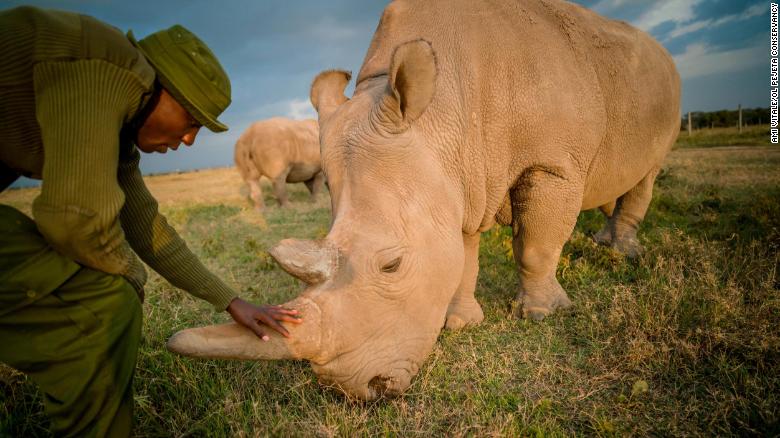That Which Humankind Has Destroyed ... To be Restored
"We are very happy that after this first procedure on Najin and Fatu that they have recovered very smoothly and they are doing really well and fine today just twenty-four hours after this first procedure."
Dr.Robert Hermes, Leibniz Institute for Zoo and Wildlife Research (IZW)
"I am pretty sure we will overcome that hurdle [perfecting the technique whereby the species can be renewed]."
"But even if we are able to have those frozen embryos and store them for 3,000 years or longer, we can say we have saved the whole organism for future generations."
IZW spokesman
 |
| Rhino keeper James Mwenda checks on Najin, one of the last two northern white rhinos on the planet |
"Both the technique and the equipment had to be developed entirely from scratch."
"We were able to harvest a total of 10 oocytes - five from Najin and five from Fatu - showing that both females can still provide eggs and thus help to save these magnificent creatures."
Professor Thomas Hildebrandt, Leibniz Institute for Zoo and Wildlife Research, Germany
"On the one hand Ol Pejeta is saddened that we are now down to the last two northern white rhinos on the planet, a testament to the profligate way the human race continues to interact with the natural world around us.""However we are also immensely proud to be part of the groundbreaking work which is now being deployed to rescue this species.""We hope it signals the start of an era where humans finally start to understand that proper stewardship of the environment is not a luxury but a necessity."Richard Vigne, managing director, Ol Pejeta Conservancy, Kenya
 |
| Fatu is surrounded by her keepers and Dr. Stephen Ngulu of Ol Pejeta before the procedure |
Animals favoured and valued, and bringing huge profit to the black marketers to be used for exotic and highly prized food preparation, recipes unique to China. And there is the matter of bones and tusks used for traditional art, proscribed by most countries of the world in recognition both of the cruelty of slaughtering great beasts and leaving their bodies to rot after their prized horns and tusks have been removed.
The prohibition against hunting endangered species hasn't stopped poaching nor the illegal trade; game preserves in Africa can be monitored but the will is there to make a way to supply the black market. All efforts to stop poaching appear to have come up hard against human greed unwilling to forfeit the opportunity to extract huge sums for prohibited goods. And those whom the black market serves appear to have little conscience respecting their illegal and immoral destruction of animal life.
Demand for rhinoceros horn for Chinese medicine and for dagger handles in Yemen were the cause of a crisis, the result of which was these animals being swept wholesale into extinction from the 1970s forward. The northern white rhino was declared extinct in the world in 2008. An animal population survey was unsuccessful in finding any live specimens in the wild. A handful of the beasts were kept on a Kenyan wildlife reserve where they were carefully monitored and protected.
There were two males left out of the huge numbers that once roamed the grassy plains stretching along the southern edge of the Sahara desert, from Uganda, the Central African Republic, Sudan and Chad. There were no natural predators, other than human beings who were more than eager to continue supplying the illegal market demanding rhino horn. One male named Suni died of natural causes in 2014. The sole remaining male then died in 2018. Leaving only two females.
Neither of the females was able to become pregnant though the older of the two had borne the younger one almost two decades ago. Najin is the daughter of the male Northern White, Sultan, who died last year. She is 28 years of age, and had given birth to a now-18-year-old female, Fatu, both of them living under 24-hour armed guard in the same reserve. Biologists involved in the preservation of a species now doomed to extinction felt it would be worthwhile extracting eggs from the two females.
Years ago, sperm had been cryonically preserved from four male rhinos. Should the scientists involved ultimately be successful in breeding living offspring with the use of the frozen sperm and eggs, the goal they envision is to create a herd of up to fifteen animals. The intent then would be to return the beasts to their natural habitat in Africa, an ambitious project that may well take a decade to succeed with.
This will represent a new procedure in artificially inseminating frozen sperm in a technique never before attempted that must be experimented with to ensure the technique can be properly perfected. The projected involves the Italian biotech laboratory Avantea, the Dvur Kralove zoo in the Czech Republic and the Kenya Wildlife Service representing an "attempt to push the boundaries of what is medically and technically feasible."
A skeptic might ask what good it would do to return fifteen animals to Kenya when the problem that led to the collapse of the species to begin with has not been solved. What is to stop that small herd of fifteen animals from becoming prey once again to unscrupulous poachers and reprehensibly unscrupulous buyers of prohibited exports?
 |
| The team performed the ovum pick-up procedure on Fatu to collect eggs from her ovaries |
Labels: Endangered, Experiment, Extinct, Kenya, Northern White Rhino, Rare Species, Threatened

0 Comments:
Post a Comment
<< Home